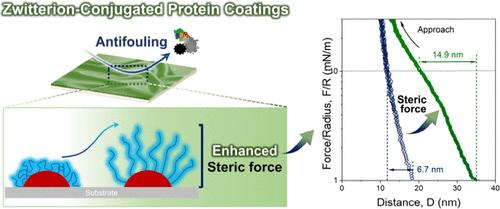Our official English website, www.x-mol.net, welcomes your
feedback! (Note: you will need to create a separate account there.)
Zwitterion-Conjugated Protein Coatings for Enhanced Antifouling in Complex Biofluids: Underlying Molecular Interaction Mechanisms
Langmuir ( IF 3.7 ) Pub Date : 2024-11-19 , DOI: 10.1021/acs.langmuir.4c03975 Ziqian Zhao, Charley Huang, Hongbo Zeng
Langmuir ( IF 3.7 ) Pub Date : 2024-11-19 , DOI: 10.1021/acs.langmuir.4c03975 Ziqian Zhao, Charley Huang, Hongbo Zeng

|
Biofouling can cause severe infections, device malfunctions, and failures in diagnostics and therapeutics. Proteins such as bovine serum albumin (BSA) have recently been used as coatings to resist biofouling because they combine surface anchoring and antifouling properties. However, their antifouling effectiveness will significantly deteriorate in complex biofluids with high salinity, limiting their practical applications. In this work, we developed a zwitterion-conjugated protein with enhanced antifouling capability by grafting zwitterionic 2-methacryloyloxyethyl phosphorylcholine (MPC) onto BSA protein via a click reaction. This conjugated protein can easily anchor on various substrates, both inorganic and organic, and exhibits efficient and broad-spectrum fouling resistance to metabolites, proteins, and complex biofluids. Even in the complex fetal bovine serum with higher salinity, the BSA@MPC coating can also maintain 99% fouling resistance robustly, over 6-fold superior to native BSA-coated surfaces in antifouling capability. Direct surface forces measurement reveals that such outstanding antifouling properties of conjugated protein BSA@MPC could be attributed to the stable hydration layer on its surface and the steric repulsion from the antipolyelectrolyte behavior of zwitterionic MPC polymer in the high-salinity environment. Our findings advance the development of protein-based functional materials and provide valuable insights for designing novel antifouling surfaces for marine, food, and bioengineering applications.
中文翻译:

两性离子共轭蛋白质涂层在复杂生物流体中增强防污作用:潜在的分子相互作用机制
生物污垢会导致严重的感染、设备故障以及诊断和治疗失败。牛血清白蛋白 (BSA) 等蛋白质最近被用作抵抗生物污染的涂层,因为它们结合了表面锚定和防污特性。然而,它们的防污效果在高盐度的复杂生物流体中会显著恶化,从而限制其实际应用。在这项工作中,我们通过点击反应将两性离子 2-甲基丙烯酰氧乙基磷酸胆碱 (MPC) 接枝到 BSA 蛋白上,开发了一种具有增强防污能力的两性离子偶联蛋白。这种偶联蛋白可以很容易地锚定在各种底物(无机和有机)上,并对代谢物、蛋白质和复杂的生物流体表现出高效和广谱的抗污染性。即使在盐度较高的复杂胎牛血清中,BSA@MPC涂层也能稳定地保持 99% 的抗污染性,在防污能力方面比天然 BSA 涂层表面高出 6 倍以上。直接表面力测量表明,共轭蛋白BSA@MPC如此出色的防污性能可归因于其表面稳定的水合层以及两性离子 MPC 聚合物在高盐度环境中的抗聚电解质行为的空间排斥。我们的研究结果推动了基于蛋白质的功能性材料的发展,并为为海洋、食品和生物工程应用设计新型防污表面提供了有价值的见解。
更新日期:2024-11-19
中文翻译:

两性离子共轭蛋白质涂层在复杂生物流体中增强防污作用:潜在的分子相互作用机制
生物污垢会导致严重的感染、设备故障以及诊断和治疗失败。牛血清白蛋白 (BSA) 等蛋白质最近被用作抵抗生物污染的涂层,因为它们结合了表面锚定和防污特性。然而,它们的防污效果在高盐度的复杂生物流体中会显著恶化,从而限制其实际应用。在这项工作中,我们通过点击反应将两性离子 2-甲基丙烯酰氧乙基磷酸胆碱 (MPC) 接枝到 BSA 蛋白上,开发了一种具有增强防污能力的两性离子偶联蛋白。这种偶联蛋白可以很容易地锚定在各种底物(无机和有机)上,并对代谢物、蛋白质和复杂的生物流体表现出高效和广谱的抗污染性。即使在盐度较高的复杂胎牛血清中,BSA@MPC涂层也能稳定地保持 99% 的抗污染性,在防污能力方面比天然 BSA 涂层表面高出 6 倍以上。直接表面力测量表明,共轭蛋白BSA@MPC如此出色的防污性能可归因于其表面稳定的水合层以及两性离子 MPC 聚合物在高盐度环境中的抗聚电解质行为的空间排斥。我们的研究结果推动了基于蛋白质的功能性材料的发展,并为为海洋、食品和生物工程应用设计新型防污表面提供了有价值的见解。


















































 京公网安备 11010802027423号
京公网安备 11010802027423号